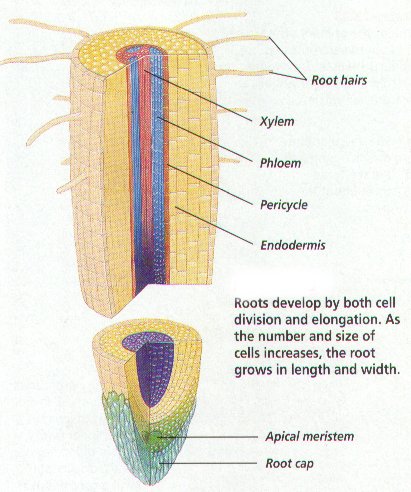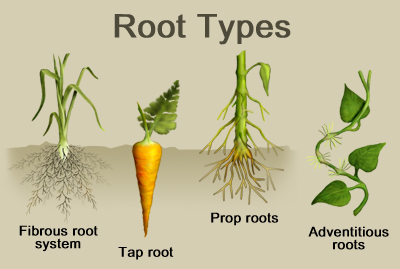Plant roots: Difference between revisions
Jump to navigation
Jump to search
No edit summary |
|||
| Line 2: | Line 2: | ||
== Overview == | == Overview == | ||
The root is typically the part of the plant that grows into the soil, although it can be aerial in waterlogged soil. Roots have two main functions, anchoring the plant to the ground, and absorbing nutrients, water, and minerals for the plant. There are typically two types of roots, tap roots and fibrous roots, | The root is typically the part of the plant that grows into the soil, although it can be aerial in waterlogged soil. Roots have two main functions, anchoring the plant to the ground, and absorbing nutrients, water, and minerals for the plant. There are typically two types of roots, tap roots and fibrous roots, but can have other types such as prop roots and adventitious roots. Plant root systems can be very extensive, and are harder to study than the above ground biomass. Current methods for studying root systems include: the harvest method, isotopic analysis, root ingrowth, and rhizotrons. Roots can often have symbiotic relationships with mycorrhizal fungi. | ||
== Parts of the plant root == | == Parts of the plant root == | ||
| Line 30: | Line 30: | ||
== Types of plant roots == | == Types of plant roots == | ||
;Tap Roots | |||
: tap | |||
;Fibrous Roots | |||
:fibrous roots | |||
;Prop Roots | |||
: prop | |||
;Adventitious Roots | |||
: | |||
[[File:roottype.jpg]] | [[File:roottype.jpg]] | ||
Gyssels, G., et al. “Impact of Plant Roots on the Resistance of Soils to Erosion by Water: a Review.” Progress in Physical Geography, vol. 29, no. 2, 2005, pp. 189–217. | |||
== Citations == | == Citations == | ||
Cannon, William Austin. “A Tentative Classification of Root Systems.” Ecology, vol. 30, no. 4, 1 Oct. 1949, pp. 542–548. | Cannon, William Austin. “A Tentative Classification of Root Systems.” Ecology, vol. 30, no. 4, 1 Oct. 1949, pp. 542–548. | ||
Glinski, J. Soil Physical Conditions and Plant Roots. CRC Press, 2018. | Glinski, J. Soil Physical Conditions and Plant Roots. CRC Press, 2018. | ||
Russell, Robert Scott. Plant Root Systems: Their Function and Interaction with the Soil. English Language Book Society and McGraw-Hill, 1982. | Russell, Robert Scott. Plant Root Systems: Their Function and Interaction with the Soil. English Language Book Society and McGraw-Hill, 1982. | ||
Esau, K. 1965. Plant Anatomy, 2nd Edition. John Wiley & Sons. 767 pp. | Esau, K. 1965. Plant Anatomy, 2nd Edition. John Wiley & Sons. 767 pp. | ||
Beeckman, Tom; De Smet, Ive (2014). "Pericycle". Current Biology. 24 (10): R378–9 | |||
Revision as of 12:33, 19 April 2018
Overview
The root is typically the part of the plant that grows into the soil, although it can be aerial in waterlogged soil. Roots have two main functions, anchoring the plant to the ground, and absorbing nutrients, water, and minerals for the plant. There are typically two types of roots, tap roots and fibrous roots, but can have other types such as prop roots and adventitious roots. Plant root systems can be very extensive, and are harder to study than the above ground biomass. Current methods for studying root systems include: the harvest method, isotopic analysis, root ingrowth, and rhizotrons. Roots can often have symbiotic relationships with mycorrhizal fungi.
Parts of the plant root
- Root Hairs
- The root hairs are thin hairlike structures growing from the epidermis. These help with the absorption of moisture and nutrients from the soil, which is then transported to the rest of the plant. The majority of plant water absorption happens with the root hairs. The length and shape allows them to have a large surface area while being able to go between soil particles, both of which helps with water absorption. In legume plants, they are involved in root nodule formation.
- Xylem
- In vascular plants, xylem transports nutrients and water in a sap from the roots to the stem and leaves. It uses passive transportation, so it does not need an input of energy to operate. The xylem is primarily composed of dead cells, and can only flow upward. This movement is mainly driven by negative pressures.
- Phloem
- In vascular plants, phloem transports the products of photosynthesis in a sap from the chloroplast down to the roots or storage structures. The sap holds a lot of sucrose, but is water-based. The phloem is primarily composed of living cells and is able to flow in many different directions. It's flow is called translocation, and is mainly caused by positive hydrostatic pressures.
- Pericycle
- The pericycle is made up of sclerenchyma or parenchyma cells in a cylindrical shape. In dicots, it gives protection to vascular bundles and strengthens the roots. In eudicots, it can create lateral roots, which grow horizontally and help anchor the plant.
- Endodermis
- Endodermis
- Apical meristem
- apical
- Root cap
- root cap
Types of plant roots
- Tap Roots
- tap
- Fibrous Roots
- fibrous roots
- Prop Roots
- prop
- Adventitious Roots
Gyssels, G., et al. “Impact of Plant Roots on the Resistance of Soils to Erosion by Water: a Review.” Progress in Physical Geography, vol. 29, no. 2, 2005, pp. 189–217.
Citations
Cannon, William Austin. “A Tentative Classification of Root Systems.” Ecology, vol. 30, no. 4, 1 Oct. 1949, pp. 542–548. Glinski, J. Soil Physical Conditions and Plant Roots. CRC Press, 2018. Russell, Robert Scott. Plant Root Systems: Their Function and Interaction with the Soil. English Language Book Society and McGraw-Hill, 1982. Esau, K. 1965. Plant Anatomy, 2nd Edition. John Wiley & Sons. 767 pp. Beeckman, Tom; De Smet, Ive (2014). "Pericycle". Current Biology. 24 (10): R378–9

